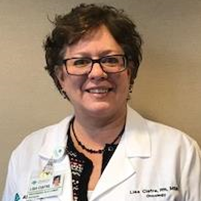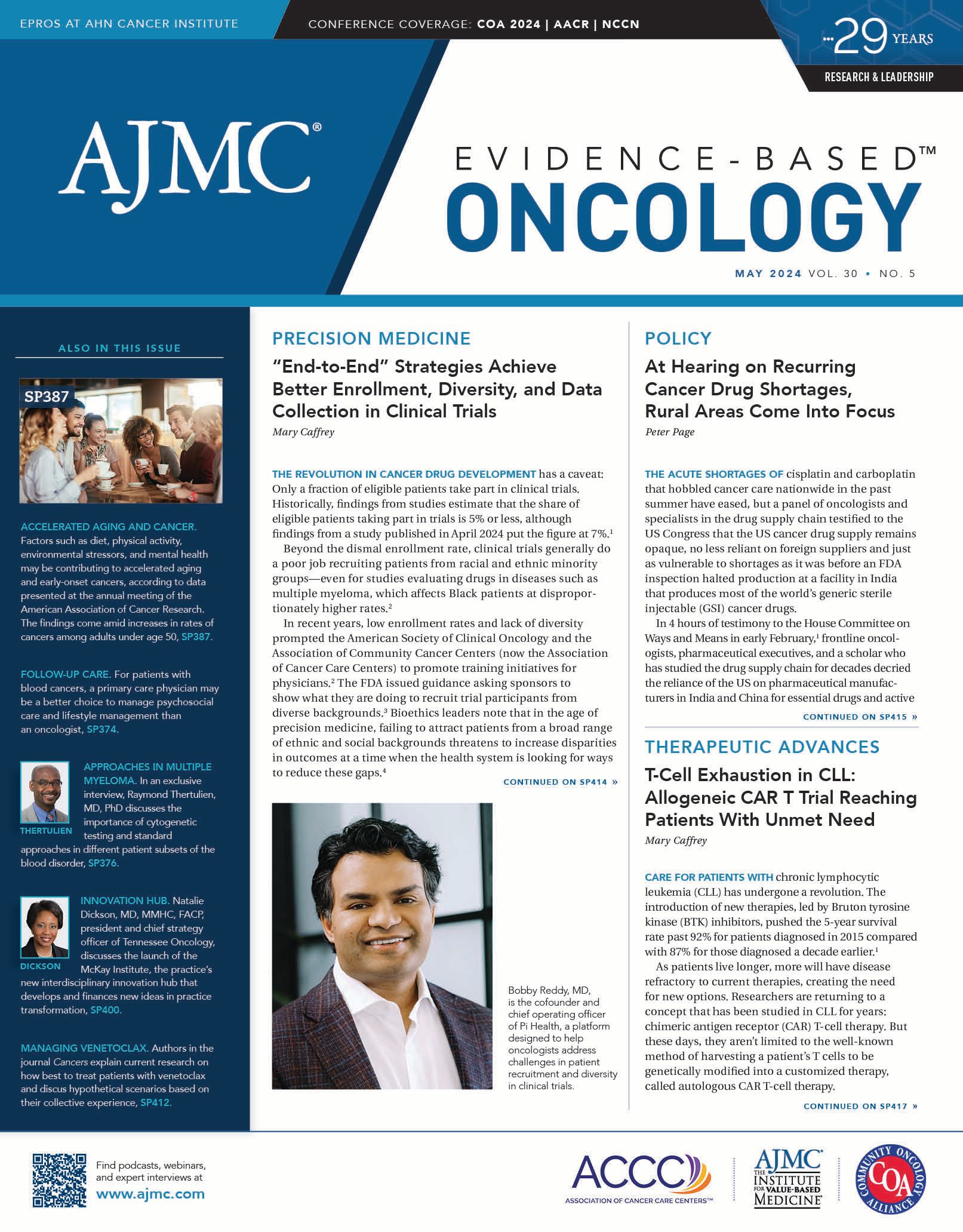- Center on Health Equity & Access
- Clinical
- Health Care Cost
- Health Care Delivery
- Insurance
- Policy
- Technology
- Value-Based Care
AHN Cancer Institute Raises the Quality and Value Bar by Listening to Patients
How do we define value in cancer care? It’s a question as old as the dawn of value-based care.
In 2010, before immunotherapies changed the cancer care landscape, Scott Ramsey, MD, PhD, and Adam Schickedanz, MD, wrote in The Oncologist that there was no standing definition of value in cancer care. Lacking one, they wrote, “An intervention in cancer care can be described as having value if patients, their families, physicians, and health insurers all agree that the benefits afforded by the intervention are sufficient to support the total sum of resources expended for its use.”1
The trouble with this concept, the authors noted, is that all stakeholders must agree.
Casey Allen, MD

In the real world, physician and patient can have very different views of value, Allegheny Health Network (AHN)’s Casey Allen, MD, explains. Allen is a surgical oncologist and lead quality officer for the AHN Cancer Institute in Pittsburgh, Pennsylvania, who has published more than 80 papers on quality delivery and patient experience. Among other topics, Allen examined perioperative support, and he has been instrumental in developing new protocols to improve the postoperative experience and speed recovery for patients who have surgery for cancer.
“Addressing the perception of value reveals a fascinating divergence between patients and providers,” Allen said in an email exchange with Evidence-Based Oncology (EBO). “While both parties generally agree on the importance of longevity and well-being over treatment costs, there is an intriguing difference in prioritization. Patients generally value their longevity above all else—a contrast to providers’ beliefs.
“Still, as many patients have different priorities, our findings underscore the need for a nuanced understanding of individual patient preferences to ensure patient-centric, value-based care. It emphasizes the importance of capturing a broad spectrum of outcomes significant to patients in treatment decision-making processes.”
Allen was the lead author of findings based on a survey of 383 patients and 164 providers, which showed that providers felt that “experience, emotional well-being, and costs were more important than patients themselves did.… Patients more commonly reported that survival had become more important to them over time, while providers believed that emotional well-being, experience, and costs had become more important to patients.”2
The survey results revealed that patients of lower income and education levels were more concerned about costs over the course of their care.2 Allen elaborated on the connection between socioeconomic status and patient outcomes, which has been a recurring theme in his scholarship3: “Our research has delved into the impact of socioeconomic factors on the quality of survivorship, revealing that patients from lower socioeconomic backgrounds often experience inferior outcomes and quality of life [QOL] following cancer therapy. This issue is a significant challenge for our health system, necessitating a focused effort to improve the outcomes for this patient group.”
The Shift to ePROs
In March, AHN Cancer Institute took a major step toward capturing that “broad spectrum” of patient experience when it launched electronic patient-reported outcomes (ePROs), which will give AHN unfiltered insight into patients’ QOL.
Lisa Ciafre, MSN, RN

“It gives the entire team insight into how they’re doing,” Lisa Ciafre, MSN, RN, director of quality for AHN Cancer Institute, said in an interview with EBO. “It’s the patient answering the questions; they are not clinician asked—we are not doing that because [it] leads to assumptions. We want to hear directly from the patient how they’re doing.”
AHN’s initiation of ePROs comes after a 2-year process, which Ciafre said included the creation of a patient and family advisory council, which is balanced equally between the patient/family representatives and staff in addition to being balanced to represent a cross section of the AHN service area and to reflect different disciplines.
“We gain insight from different experiences,” Ciafre said. Much of the front-end work involved in selecting a vendor and setting up ePROs was designed to ease the collection process into the workflow and not create new burdens. Patients will receive a survey from a third party every 30 days, she explained, but protocols will prevent patients from getting back-to-back surveys connected to their surgical oncology appointment followed by medical oncology, for example.
“The last thing patients want is to have another questionnaire to answer. The last thing our clinicians want is another button to click,” she said. “So how do we launch this so it’s user friendly but gives us the insight in[to] the quality of life that our patients have? Because that is what it’s all about.”
Connecting Quality of Life and Value
Value and QOL are different aspects of cancer care, but they are closely related; the movement toward greater focus on patient QOL has left an unmistakable imprint on the way surgical oncology is practiced and creates value for patients, Allen said.4 And if this speeds patient recovery and reduces readmissions, it creates value for the health system too.
“Quality-of-life research has significantly influenced surgical protocols, procedures, and equipment, aiming to minimize pain, discomfort, and temporary disability from major cancer surgeries,” he said. “Enhanced recovery protocols, preoperative optimization through exercise and nutrition, and the use of minimally invasive techniques and multimodal pain management strategies are pivotal. These initiatives are designed to expedite patients’ return to normalcy and continuation of curative cancer therapy.”
As Ciafre explains, improving quality in cancer care involves both the global picture and the individual tactics. Although tactics may involve things such as preventing falls or steps to promote patient safety, the big picture for AHN is no different from what other health systems face: continuing the shift from fee-for-service to outcomes-based reimbursement alongside a more recent shift from hospital- to ambulatory-based care.
“We’re more focused now on disease prevention, not just a cure,” Ciafre said. “How do we keep people healthy? How do we make sure we detect cancer sooner rather than later to improve outcomes?”
Robin Rowell, RN, CNP

Much of the work in quality care initiatives is about “removing barriers,” Robin Rowell, RN, CNP, service line vice president for AHN Cancer Institute, said. Like Ciafre, Rowell started as a nurse clinician and began working with institution-level committees or other efforts to deliver care more effectively.
“What I’ve enjoyed as far as having a clinical background is being able to see opportunities where we can improve access and our timeliness of care for our patients,” Rowell, who joined AHN in the fall of 2023, said.
Rowell noted the AHN network hospitals are teaching hospitals, so there is plenty of education about the shifts in reimbursement and site of care and what it means for both patients and providers. “It’s really important to bring that education piece for awareness and detection and treatment.”
Getting the Right Data and Metrics
As more patients are treated in the ambulatory setting, Ciafre explained that data collection becomes more challenging. As AHN moves forward with focusing on patient experience, she said, the questions that come up are whether the health system is ready for measuring quality of care outside a hospital setting.
“Is Epic, who [provides] our electronic health record, really ready for that?” Ciafre asked. “Because it’s not just oncology, you know; it’s every specialty.” The question becomes whether quality can be measured with the same richness in an ambulatory space as it was in a hospital space. Claims data become critical, she said.
Across the nation, she said, health systems are grappling with what data points matter when the care setting is the patient’s home. “We’re decreasing admissions and [emergency department] visits. That’s kind of black and white, but how was their quality of life? And when they’re not in the hospital bed, it’s easy, right? Because we’re face to face, in their home. Everything changes. So I think that’s going to be a challenge for everyone.”
In Allen’s view, the value of QOL research in driving shorter hospital stays and improved outcomes is “undeniable.”
“Enhanced recovery protocols and perioperative support in exercise and nutrition empower patients to maintain strength and recover robustly from surgery,” he said. “This approach directly enhances their quality of life during and after cancer treatment.”
References
1. Ramsey S, Schickedanz A. How should we define cancer care? Oncologist. 2010;15(suppl 1):1-4. doi:10.1634/theoncologist.2010-S1-1
2. Allen CJ, Smith GL, Prakash L, et al. What is “value”? results of a survey of cancer patients and providers. Ann Surg Oncol. 2022;29(11):6537-6545. doi:10.1245/s10434-022-11534-z
3. Maxwell CM, Bhat A, Falls SJ, et al. Socioeconomic factors predict long-term quality of life of cancer survivors: an international survey. J Surg Res. 2024;293:389-395. doi:10.1016/j.jss.2023.09.011
4. Allen CJ, Johnson FM, In H, Katz MHG, Snyder RA. Shifting the focus: value-based care in surgical oncology. Ann Surg Oncol. 2023;30(7):3871-3874. doi:10.1245/s10434-023-13369-8

AI in Health Care: Balancing Governance, Innovation, and Trust
September 2nd 2025In this conversation with Reuben Daniel, associate vice president of artificial intelligence at UPMC Health Plan, we dive into how UPMC Health Plan builds trust with providers and members, discuss challenges of scaling AI effectively, and hear about concrete examples of AI's positive impact.
Listen
